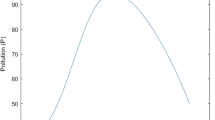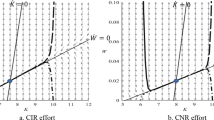Abstract
In this paper we consider an endogenous growth model involving, among other inputs, a renewable resource and secondary materials. Using this analytical framework we explain the effects of waste recycling on the growth rate of the economy, that we take into account. The effects of secondary materials production on the utility and dynamics of renewable resources are also studied. Furthermore, we consider how taxes and subsidies, levied on natural resources and granted for secondary materials, influence the dynamics of the economy during the transitional phase and the stationary growth path. Finally, the validity of Hotelling’s rule and the effects of waste recycling on labor productivity are the conclusive topics of our research.
Similar content being viewed by others
References
E.B. Barbier, Endogenous growth and natural resource scarcity, in: Discussion Papers in Environmental Economics and Environmental Management n. 9601 (University of York, 1996).
C. Berglund and P. Söderholm, An econometric analysis of global waste recovery and utilization, forthcoming in Environmental and Resource Economics.
J. Blomberg and S. Hellmer, Short run demand and supply elasticities in the West European market for secondary aluminium, Resources Policy 26(1) (2000) 39–50.
J. Cassing and T. Kuhn, The political economy of strategic environmental policy when waste products are tradeable, Mimeo (2001).
C.W. Clark, Renewable resources: fisheries, in: Handbook of Environmental and Resource Economics, ed. J.C.J.M. van den Bergh (Edward Elgar Ltd., Cheltenham, 1999).
K. Conrad, Resource and waste taxation in the theory of the firm with recycling activities, Environmental and Resource Economics 14 (1999) 217–242.
B.R. Copeland, International trade in waste products in the presence of illegal disposal, Journal of Environmental Economics and Management 20 (1991) 143–162.
G. Di Vita, Macroeconomic effects of the recycling of waste derived from non-renewable raw materials, Resources Policy 23(4) (1997) 179–186.
G. Di Vita, Technological change, growth and waste recycling, Energy Economics 23(5) (2001) 549–567.
G. Di Vita, Exhaustible resources and secondary materials: a macroeconomic analysis, Mimeo (2001).
Environmental Protection Agency (EPA), Factbook (Washington, United States, 1998).
S. Faucheux and M. O’Connor, Valuation for Sustainable Development (Eduard Elgar Ltd., Cheltenham, 1998).
R.R. Grace, K. Turner and I. Walter, Secondary materials and international trade, Journal of Environmental Economics and Management 5 (1978) 172–186.
N. Hanley, J.F. Shogren and B. White, Environmental Economics in Theory and Practice (MacMillan, London, 1997).
M. Hoel, Resource extraction and recycling with environmental costs, Journal of Environmental Economics and Management 5 (1978) 220–235.
A. Huhtala, Optimizing production technology choices: conventional production vs. recycling, Resources and Energy Economics 21 (1999) 1–18.
E. Keeler, M. Spence and R. Zeckhauser, The optimal control of pollution, Journal of Economic Theory 4 (1971) 19–34.
C.-Z. Li and K.-G. Löfgren, Renewable resources and economic sustainability: a dynamic analysis with heterogeneous time preferences, Journal of Environmental Economics and Management 40 (2000) 236–250.
R.E. Lucas, Jr., On the mechanics of economic development, Journal of Monetary Economics 22 (1988) 3–42.
R. Lusky, A model of recycling and pollution control, Canadian Journal of Economics 9 (1976) 91–101.
G.N. Mankiw, D. Romer and D.N. Weil, A contribution to the empirics of economic growth, Quarterly Journal of Economics CVII (1992) 407–438.
D.L. McKee, Some reflections on the international waste trade and emerging nations, International Journal of Social Economics 23(4) (1996) 235–244.
J.L. Mosak, Interrelation of production, price, and demand, Journal of Political Economy 46(6) (1938) 761–787.
P.A. Neher, Natural Resource Economics. Conservation and Exploitation (Cambridge University Press, New York, 1990).
OCDE, Recycling of Copper, Lead and Zinc Bearing Wastes, Environment Monographs no 109, Paris (1995).
V. Rich, H. Bryant and P. Kearney, Macroeconomic implications of recycling: a response to Di Vita, Resources Policy 25(2) (1999) 141–142.
P. Schou, Polluting non-renewable resources and growth, Environmental and Resource Economics 16 (2000) 211–227.
V.L. Smith, Dynamics of waste accumulation: disposal versus recycling, Quarterly Journal of Economics LXXXVI (1972) 600–616.
J.E. Stiglitz, Growth with exhaustible natural resources: efficient and optimal growth paths, Review of Economic Studies (special issue on natural resources) 41 (1974) 123–137.
P.J.H. Van Beukering, Recycling, International Trade and the Environment: An Empirical Analysis (Kluwer Academic Publishers, Dordrecht, The Netherlands, 2001).
P.J.H. Van Beukering and B. Mathijs, Starting from scrap: understanding trade in secondary materials between recycling industries of developing and developed countries, World Development 29(10) (2001) 1717–1737.
P.J.H. Van Beukering, J.C.J.M. van den Bergh, M.A. Janssen and H. Verbruggen, International material-product chains, Tinbergen Institute Discussion Paper 2000-034/3 (2000).
P.J.H. Van Beukering and R.T. Curlee, Recycling of materials. Local or global?, in: Managing a Material World, eds. P. Vellinga, J. Gupta and F. Berkhout (Kluwer Academic Publishers, Dordrecht, 1998).
R.C. Williams, III, Environmental tax interactions when pollution affects health or productivity, NBER Working Paper Series n. 8049 (December 2000) 1–24.
World Trade Organization, Trade and Environment (WTO Publication, Geneva, 1999).
Author information
Authors and Affiliations
Rights and permissions
About this article
Cite this article
Di Vita, G. Renewable resources and waste recycling. Environ Model Assess 9, 159–167 (2005). https://doi.org/10.1007/s10666-005-3798-2
Issue Date:
DOI: https://doi.org/10.1007/s10666-005-3798-2




